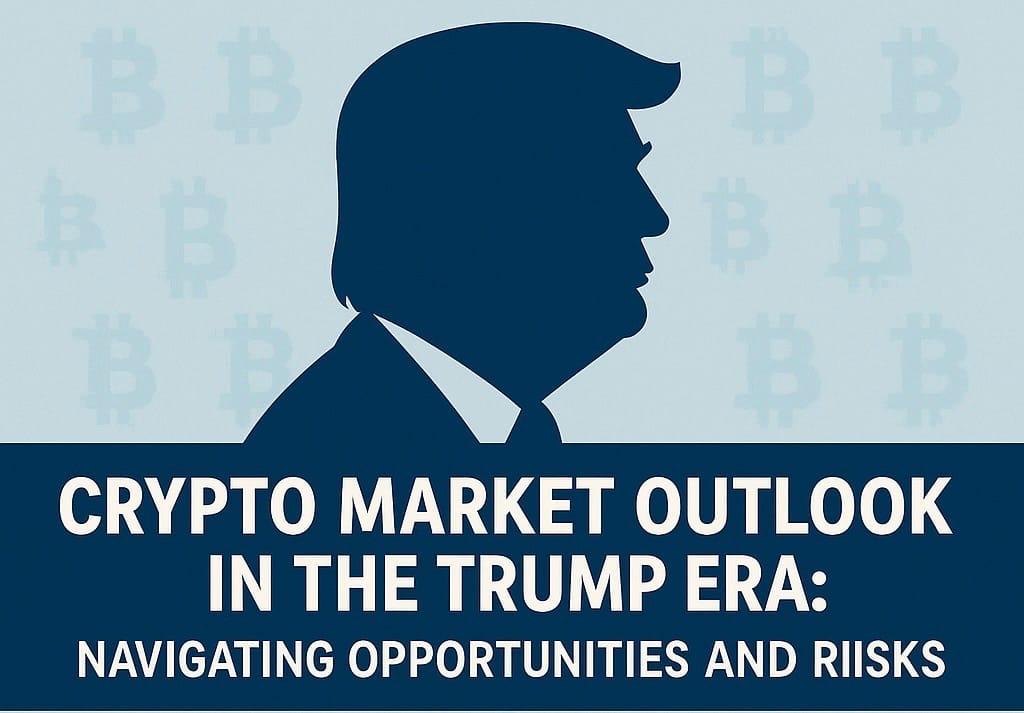Crypto Market Outlook in the Trump Era: Navigating Opportunities and Risks

Introduction
The re-election of Donald Trump in 2024 has ushered in a transformative period for the cryptocurrency market. With a series of pro-crypto policies and strategic initiatives, the Trump administration aims to position the United States as a global leader in digital assets.
This article delves into the implications of Trump’s policies on the crypto market, exploring potential opportunities and inherent risks.

1. The “Trump Bump”: A Catalyst for Crypto Growth
Following Trump’s re-election, the cryptocurrency market experienced a significant surge, often referred to as the “Trump Bump.”
Bitcoin, the flagship cryptocurrency, saw its price soar above $100,000, reflecting investor optimism about the administration’s crypto-friendly stance .
Analysts from Bernstein projected that Bitcoin could reach between $80,000 and $90,000 under Trump’s leadership, attributing this to anticipated regulatory leniency and supportive policies .
Standard Chartered offered an even more bullish forecast, suggesting that
Bitcoin could climb to $125,000, driven by the administration’s favorable approach to digital assets.
2. Strategic Bitcoin Reserve: Institutionalizing Crypto
In a landmark move, President Trump signed an executive order establishing the Strategic Bitcoin Reserve and the U.S. Digital Asset Stockpile . This initiative aims to solidify Bitcoin’s role as a national reserve asset, utilizing forfeited digital assets to bolster the reserve. The administration’s vision includes expanding the reserve to encompass other prominent cryptocurrencies such as Ethereum (ETH), Solana (SOL), Cardano (ADA), and Ripple (XRP) . This strategic accumulation signals a commitment to integrating digital assets into the nation’s financial infrastructure.
3. Regulatory Reforms: Fostering Innovation
Trump’s administration has embarked on a deregulatory trajectory to stimulate innovation within the crypto sector. Key measures include:
• Revocation of Previous Executive Orders: Executive Order 14178 nullified prior directives that were perceived as restrictive, paving the way for a more accommodating regulatory environment .
• Formation of the Presidential Working Group on Digital Asset Markets: This body is tasked with developing a comprehensive regulatory framework for digital assets, aiming to provide clarity and support for the burgeoning industry.
• Limiting SEC Oversight: The administration has expressed intentions to curtail the Securities and Exchange Commission’s (SEC) authority over cryptocurrencies, advocating for reduced compliance burdens and promoting self-regulation within the industry .
4. Market Dynamics: Navigating Volatility
While the administration’s policies have invigorated the crypto market, they have also introduced new dynamics:
• Meme Coin Volatility: The impending release of 40 million Trump-affiliated meme coins, valued at approximately $320 million, has raised concerns about market dilution and potential price declines .
• Institutional Maturity: Despite recent price fluctuations, analysts note that the crypto market has demonstrated resilience, with downturns being less severe compared to previous years, indicating growing maturity in the asset class .
5. Ethical Considerations and Criticisms
The intertwining of the Trump administration’s policies with personal and familial interests has sparked ethical debates:
• Conflict of Interest Allegations: Critics argue that the administration’s deregulatory measures coincide with the Trump family’s expanding footprint in the crypto industry, raising questions about potential conflicts of interest .
• Regulatory Integrity Concerns: The disbanding of certain regulatory units and the appointment of crypto-friendly officials have led to apprehensions about the erosion of regulatory safeguards and the potential for increased illicit activities.
6. Global Implications: Shaping International Crypto Policies
The United States’ aggressive stance on crypto under Trump’s leadership has international ramifications:
• Setting Precedents: Other nations may emulate the U.S.’s approach, leading to a global shift towards integrating cryptocurrencies into national financial systems.
• Regulatory Arbitrage: Countries with stringent crypto regulations might experience capital flight to more accommodating jurisdictions, influencing global financial flows and regulatory strategies.
7. Future Outlook: Balancing Innovation and Oversight
The trajectory of the crypto market under the Trump administration presents a blend of opportunities and challenges:
• Market Growth Potential: Supportive policies could attract investments, foster innovation, and solidify the U.S.’s position as a crypto hub.
• Need for Balanced Regulation: Ensuring investor protection and market integrity remains crucial. Striking a balance between fostering innovation and maintaining oversight will be essential to sustainable growth.
The Impact of Trumps Era on the Mitosis Ecosystem
The Trump administration’s pro-crypto stance could be a significant tailwind for modular, interoperable ecosystems like Mitosis. At its core, Mitosis is focused on creating seamless liquidity movement and interoperability across chains—a design philosophy that aligns well with the deregulated, innovation-forward landscape Trump’s policies are ushering in.
Under Trump, we’re seeing a clear trend toward reducing federal oversight and allowing crypto innovation to flourish organically. This favors modular protocols that thrive in fast-moving, less-constrained environments. Mitosis, with its plug-and-play stack and permissionless interchain communication, can now deploy and integrate across U.S.-based chains and platforms more freely, avoiding the bottlenecks that might have existed under more rigid regulatory frameworks.
Also, the Trump-era push for a Strategic Bitcoin Reserve and a broader U.S. digital asset stockpile suggests an increased federal appetite for cross-chain holdings. This opens a unique niche for Mitosis. As the U.S. begins to diversify its on-chain reserves and potentially allocate funds across different ecosystems, Mitosis could serve as a neutral bridge for liquidity flows—connecting Bitcoin-backed reserves to Ethereum L2s, Solana, Cosmos, or even newly emerging U.S.-backed chains.
Moreover, the administration’s goal to limit the SEC’s reach might fast-track the launch and integration of tokenized assets and synthetic dollars—an area where Mitosis could play a vital role in enabling seamless cross-chain settlement, synthetic asset arbitrage, or real-world asset (RWA) flows. If U.S.-based protocols start issuing treasury-backed RWAs, Mitosis could become the liquidity rail connecting them across networks.
In short, Trump’s pro-crypto policies don’t just benefit Bitcoin maxis. They’re creating a fertile environment for modular cross-chain infrastructure like Mitosis to become indispensable in the coming wave of sovereign-grade, multi-chain capital movement
Conclusion
President Trump’s second term has undeniably catalyzed significant developments in the cryptocurrency landscape. While the administration’s policies have invigorated the market and positioned the U.S. as a potential leader in digital assets, they also underscore the importance of ethical governance and balanced regulation. As the crypto market continues to evolve, stakeholders must navigate this dynamic environment with diligence and foresight.
Note: The information provided in this article is based on recent available data, and is intended for informational purposes only. Investors should conduct their own research and consult with financial advisors before making investment decisions.



Comments ()